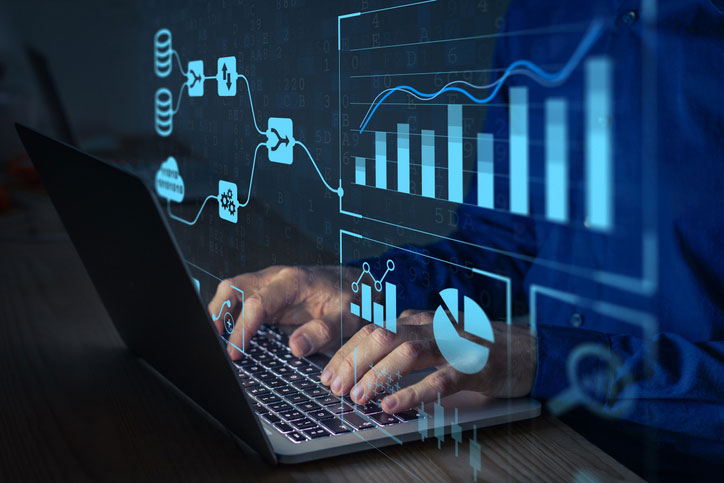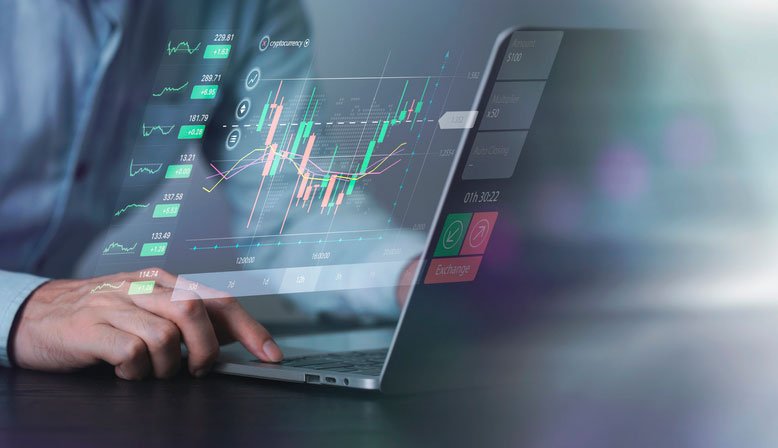Data Science Trends 2023
The field of data science has been growing in prominence for decades, as technological advancements have changed our present and offered glimpses of what’s to come in the future. For those working in the field of big data – or preparing to enter it – it’s important to understand the many arenas in which data science is evolving.
Indeed, based on the exponential rate at which technology is currently advancing, each year is likely to bring even more change than the previous. 2023 is likely to be no different, with several pieces of significant data science news that any big data professional should take note of.
This article will survey some of the biggest pieces of data science news headed our way in the year to come.
Included in this Article:
- Key Themes in Data Science
- Data Analytics
- Artificial Intelligence
- Data Science Jobs
- Cloud Based Operations
- Data Visualization Advancements
- DaaS
- Deepfake Video and Audio
- Python Growth
- Cybersecurity
- Additional Resources
2023 Trends in Data Science: An Overview of Key Themes
If the 21st century has shown us anything, it’s that big data is only going to continue to get… well, bigger. In fact, even the name “big data” makes reference to the ever-expanding nature of information technology that allows for more and more valuable data to be captured and interpreted. Over the last thirty years especially, we’ve witnessed the way that these insights can transform how entire industries operate, from enhancing marketing research and development to identifying areas for improvement in a company’s production model.
But if big data has been trending for so long already, what developments is it likely to undergo in the year to come? Experts have identified a few of the following as key concerns for big data professionals in 2023:
- Advancing tools. Developments in A.I. and machine learning are certain to continue to make leaps in the coming year, which in turn will greatly impact the instruments data scientists have at their disposal to perform their research and analysis. This has already significantly impacted most branches of data science, all of which employ machine learning tools to function. In part, this is because of the next factor on the list…
- Higher volumes of data. As a direct result of the advances in A.I. and M.L. listed above, businesses are receiving a significantly larger amount of data of all sorts. Some of this expands upon previously existing datasets while other advances have brought in new forms of data altogether. In both cases, adaptations are required to allow businesses to make use of this data as well as finding safe and affordable ways to store it. As you will see, this will be critical in businesses across industries.
- Security threats. For better or worse, these are a perennial trend in the world of data science, with new forms of cyberattack emerging constantly. For those working in the field of cybersecurity, this means strategic planning and rigorous research to identify data breaches as well as preventing new ones. For everyone else working in big data, it means that vigilance is always imperative, as certain types of cyberattacks like phishing and other forms of data related fraud involve deceptive tactics that could target them.
Read on to discover our list of the specific data science trends of 2023 for insight into where we are and where we’re headed.

Data Analytics
Analytics is one of the key fields of data science likely to undergo major transformations in the year ahead. Below are a few of the new data analytics trends to look out for.
Real-Time Analytics
One of the top rising data trends of 2023 is real-time analytics. Data capturing tools have improved in speed and scope, meaning we have access to an even greater wealth of real-time information that can illuminate our understanding of all sorts of processes. Companies are only just at the beginning of learning how these data sets can be used to guide important business decisions. If you are a data analyst or work in a related field, it will be of great use to follow any news and updates about real-time analytics that arise over the course of this year.
Mobile Analytics
Though it might seem like it couldn’t possibly continue to grow, the presence of mobile devices is ever-expanding in communities all over the globe. This means that there is significantly more mobile data to be captured. For certain industries, mobile analytics are the core of their strategy, providing the most revealing and useful information to guide marketing and advertising tactics. This includes registering user engagement, customer satisfaction, monitoring in-app traffic, and identifying security threats.
Artificial Intelligence
Recent years have made clear that artificial intelligence has made monumental leaps that are likely to change not only the way we do business but the way we live. Outside of data science, this has already risen to popular consciousness: A.I. programs that augment or generate images and texts have already begun to trend even among those who don’t know much about information technology.
Below are a few of the ways that artificial intelligence is likely to continue to trend in 2023.
Augmented Analytics
Within the field of big data, one of the main ways artificial intelligence is being employed is to help collect the ever-increasing amounts of data being captured and stored by new devices. This is in step with the global population’s increased dependence on technology to go about their everyday lives.
In order to keep up with the huge amounts of information that are continuously coming in, machine learning and AI tools are improving their processing functions to expedite this process, preparing and meaningfully analyzing a tremendous amount of new data. This is known as Augmented Analytics, and it can help businesses vastly.
Augmented analytics also fits into the category of Business Intelligence. The field is expected to grow at a breathtaking speed in the years to come.
Deep Learning
When people think of A.I., what they imagine is most comparable to deep learning, the branch of artificial intelligence devoted to training computers to behave like humans. These respond to neural network architectures and large sets of data that so far have been shown to be demonstrably effective. Indeed, in 2023 data scientists and casual observers alike are likely to take note of the increasing ability of computers to mirror human interactions.
For businesses, deep learning can be used to anticipate human behaviors, which in turn can impact areas including marketing and overall business strategies. As this technology grows more sophisticated, it will only continue to transform our approach to customer service and impact how businesses understand their customers’ needs.

Data Science Jobs
For those who are considering breaking into the field of big data, here’s some exciting data science news: according to the Bureau of Labor Statistics, careers in big data are likely to be trending for years to come. This translates to more job openings and higher overall salaries, as data scientists are becoming ever-more valued by employers in all different sorts of industries.
Indeed, the numbers for data scientists are impressive by any metric: the Bureau of Labor Statistics reports an estimated job growth rate of an astonishing 36% by 2031, which is significantly higher than estimates for other professions. Over the years, different regions across the United States have become hubs for the tech industry, meaning an especially high concentration of data science job opportunities are available. Statistics from May 2021 reveal that the states with the highest employment levels for data scientists are California, New York, Texas, North Carolina, and Illinois.
In step with job growth projections, average data science salaries are exceptionally high relative to other professions. The Bureau of Labor Statistics reports a median annual salary of $100,910, with those in the highest-earning industry of scientific research and development earning a median annual salary of $102,750.
Businesses And Enterprises Moving To Cloud-Based Operations
In step with the increased amounts of data being captured by advanced tools, there is a growing need for enhanced storage solutions. Cloud computing is quickly being embraced as the solution to this problem, offering vastly improved storage opportunities that can keep up pace with the changing state of data capturing. In fact, most are beginning to consider it the very environment in which data-based business will be stored moving forward, though other storage options are technically available.
Of cloud-based computing service options available, the current game-changer is hybrid cloud, which makes use of machine learning and A.I. technology to offer a centralized database that is more cost-efficient than private cloud solutions (which can be all but completely out of reach in terms of cost for smaller businesses) and more secure than public cloud options. The hybrid cloud option is likely to become even more popular in 2023.
Cloud computing impacts the field of big tech in an enormous variety of ways, touching the fields of data science, customer interactions, Artificial Intelligence, transactional systems, DevOps, and more. If you are interested in or employed in any of those fields, staying abreast of developments in cloud-based technology will be crucial to managing your database efficiently and preserving it for the long term.
Data Visualization Advancements
Several advancements in the field of data visualization are likely to be notable in 2023. Below are a few of the most important pieces of data science news to follow.
Data Visualization Videos
Those who are interested in pursuing careers in data visualization will be interested to learn about the trend toward using video for data visualization. Opting to use video instead of photos or text has been shown to significantly increase not only viewers’ engagement while watching but also increase their levels of fact retention in the days and even weeks after reviewing the data.
The central goal of data visualization is to help translate highly inaccessible information to be not comprehensible for business leaders who will make key decisions based on their findings. Because of this, sharing data sets through an entirely new medium that has been proven to be effective could be game changing for the field, expanding our capacity to learn at the same time that we expand our access to data.
Mobile-Optimized Visualization
Those who work in the arena of data visualization must be mindful not only of not only the medium in which they are working but the interface on which it will be seen. For those who provide data visualizations for remote clients, it’s important to remember that they may often review data visualizations on their mobile devices, meaning your visualization methods must be optimized to suit phones and tablets in addition to computers. Though it may sound simple, ease of access is a crucial factor in establishing long-term relationships with your clients, which means it’s imperative to confirm that your visualization products are reaching them quickly and straightforwardly. This is another data science trend to look out for in 2023.

Data as a Service (DaaS)
Having already begun to blossom, the field of DaaS is likely to continue to expand. For those not familiar with the term, Data as a Service is the industry in which organizations that have worked with data for decades share their expertise as well as their intellectual property with clients. This is because they possess uncommon insight into the workings of data that many data scientists seek to cultivate.
Because of the data industry’s ever-growing boom, Data as a Service is all but guaranteed to become an even more widespread industry, offering a great number of job opportunities to those who wish to specialize in the field. This is yet another piece of data science news to stay on the lookout for, as it’s likely to become a crucial part of data management.
Deepfake Video And Audio
Deepfake technology is another example of a tech-world development that has captured attention far outside of the field of big data. This is technology that can vividly create audio or video content by manipulating existing documents. Already, convincing video and audio clips have surfaced featuring public figures saying or doing things that they did not actually do, with highly destructive consequences. Indeed, the implications of this are vast, posing threats not only to the reputations of individuals but also causing destructive political misunderstandings.
Beyond these public examples of deepfake technology being weaponized, businesses in particular should be on the lookout for deepfake scams. Amazing though it may seem, the speech patterns and voices of individuals can be learned and mimicked by machines and used in automated cyberattacks. One famous example of this was in 2019, when a U.K.-based energy company was scammed out of close to a quarter million euros by a fraudulent phone call made using deepfake software to imitate the voice of a top-ranking executive.
Unfortunately, concern about deepfake technology will only continue to grow as machines continue to improve, becoming more convincing in what they are able to represent, quicker in their execution, and accurate in their responsiveness when interacting with real individuals. For those interested in the field of cybersecurity, this is an important new type of cyberattack to consider.
Python Growth
Python has long been one of the leading programming languages in data science, and in recent years has become the standard programming language for those in the field of data analysis. This is only likely to increase in the coming year, thanks to its relative ease of use (it is many beginners’ first programming language), its large number of data science libraries and machine learning libraries, and its availability for use in designing blockchain applications. Because of this, experts suggest that we are likely to see Python become the #1 programming language overall for data scientists, outpacing the other leading programming languages (javascript, java, and r).
If you are interested in pursuing a career in the data sciences, the message here is clear: if you have a choice of which programming language to learn first, Python is your strongest choice. Because of its rising popularity, it is possible that your degree program will also make teaching Python a priority for new students.

Cybersecurity
Below are a few of the key issues in cybersecurity that data scientists will face in the year ahead.
Adversarial Machine Learning Combating
Among the key targets of recent cyberattacks have been machine learning algorithms – the same system that has been radicalizing the world of big data in a whole variety of ways mentioned above. To prevent this, cybersecurity experts are working overtime to study adversarial machine learning to understand how these attacks work and what they can do to help prevent them in the future.
Indeed, there is reason to fear that these systems are under threat. A recent study by the Institute of Electrical and Electronic Engineers (IEEE) speaks in no uncertain terms, stating, “industry practitioners are not equipped with tactical and strategic tools to protect, detect and respond to attacks on their Machine Learning (M.L.) systems.” They argue that this is because data science research has so far been out of step with the rapidly growing capacities of M.L., which, being so instrumental to so many big data functions, is a major target for cyberattacks. Their study reveals that these systems themselves are not just attractive to cyberattackers but highly vulnerable, as they are insufficiently understood by data scientists.
For those interested in pursuing careers in cybersecurity, advances in adversarial machine learning is a piece of data science news to follow in 2023, as it is likely to make a lasting impact on many parts of the cybersecurity profession.
Consumer Data Protection
Security scandals have been a huge part of data science news over the years, in particular the Cambridge Analytica scandal, which exposed the illegal harvesting of private data accessed through individuals’ Facebook accounts to inform political campaigning. Indeed, data breaches of this nature are a huge source of anxiety and outrage among the public. This expands the job of cybersecurity experts whose efforts will not only help protect the companies they work for but will also contribute to the overall data safety of the public.
While cybersecurity experts will help figure out best practices for creating security programs as well as strategies to prevent increasingly sophisticated cyberattacks, there will also be significant efforts made in the realm of data science law to curb organizations’ and individuals’ ease of accessing data that is meant to be private.
Additional Resources for a Career in Data Science
If reading our Data Science Trends 2023 list is making you excited about the many developments in big data that are already transforming our world, you may be a perfect candidate to pursue a data science degree. As the article above may have made clear, there is a huge variety of career paths available in the world of data science, and choosing one early will help you gain the education and specialized skills you need to build a thriving career.
To learn more about the many career paths you can take in the world of big data, take a look at our comprehensive guide here.
One of the most popular specializations for data scientists is the field of data analytics, which itself can lead to a huge number of more specific focus areas. To learn more about the world of analytics and discover if it may be the right path for you, visit our guide to a career in analytics here.
After determining your area of focus, the next step is to find the data science program that is right for you. Data scientists can hold a huge variety of degrees and certifications, though the most common route to a high-earning data science career is through a master’s degree program. To learn more about educational opportunities and find the one that is right for you, visit our data science program guide here.
Finally, if you have great abilities with numbers but aren’t certain which industry is the right one to plot your career, we can help you survey the many options available to you. Our guide to exploring a career with numbers will give you the lay of the land so you can make a decision that will make the most of your interests and skills.






